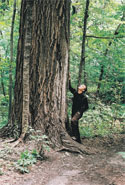By John Gurda
Milwaukee Journal Sentinel
July 5, 2008
http://www.bishop-accountability.org/AbuseTracker/
If you want a glimpse of the old Milwaukee, go to Seminary Woods. I don’t mean the city of beer gardens and Turner halls that our German ancestors left behind, and I’m not talking about the hardscrabble frontier town of Solomon Juneau’s day. I mean Milwaukee as it existed for centuries before there was a single white face on the entire continent.
Seminary Woods is 70 pristine acres of forest and wildflowers adjoining St. Francis Seminary on Milwaukee’s south lakefront. With 120 species of native plants, including an endangered goldenrod, it is one of the last and least-spoiled remnants of the landscape that once covered most of Milwaukee County. This is the world that the Potawatomi and their neighbors knew.
 |
| St. Francis Seminary has been educating priests for the Milwaukee Archdiocese since 1856. Photo by |
The Woods would be a distinguished survivor almost anywhere in southern Wisconsin. The fact that it has survived only four miles from Milwaukee’s downtown is little short of miraculous. For that we can thank the Catholics. Ever since a group of Franciscan nuns made the first land purchase in 1849 and German-speaking seminarians joined them in 1856, the forest remnant has been managed as a place of rest and reflection.
Today, however, Seminary Woods may be as endangered as some of its plants. The Archdiocese of Milwaukee is looking for ways out of the financial crisis that the clergy sex abuse scandal has created. The Woods is in no immediate danger, according to archdiocesan spokesman Jerry Topczewski.
“The protection and preservation of the Woods has always been a priority,” said Topczewski. “Care for God’s creation is one of the principles of Catholic teaching.”
 |
| Adam Lohrmann looks up at the largest tree in Seminary Woods, an eastern cottonwood nearly six feet in diameter. Photo by |
But the sex abuse scandal and its related costs have all the appearances of a bottomless pit. The Cousins Center is already on the block, and the Woods could ultimately suffer the same fate.
That threat has sparked a grass-roots effort to save the property. A coalition of concerned neighbors, community activists and the national Conservation Fund has been organized in the last year. Its members hope to combine private fund-raising with federal and state stewardship grants to buy Seminary Woods from the Archdiocese and keep it wild forever.
A walk in the woods demonstrates why this piece of land is so special. When you enter the forest on a warm summer day, the temperature drops 10 to 15 degrees, and you find yourself in the company of stately beech, maple, oak and basswood trees, some of them well more than a century old.
 |
| A historic cemetery in the Woods is the final resting place of seminary teachers, nuns and Archbishop Frederick Katzer. Photo by |
The annual parade of spring wildflowers has drawn to a close: trillium, trout lily, wood anemone, spring beauty and a host of other ephemerals that must bloom, set seed and die back in the few weeks before the tree canopy shuts out the sunlight. Although mosquitoes are now more numerous than mayapples (don’t forget the repellent), the procession of flowers will continue into the goldenrods and witch hazels of fall. Four bridges cross Deer Creek as it meanders through the Woods, and the bottomlands support a wetter class of plants, including skunk cabbage, marsh marigold and swamp buttercup.
Wildlife is never far away. Spring birding can be spectacular, and visitors report seeing fox often, deer regularly and coyote occasionally. For the last few years, a pair of resident great horned owls has produced fluff ball chicks that delight those lucky enough to see them on the nest.
The Catholic presence is still obvious. Various shrines are scattered through the Woods, most of them in ruins, but one, honoring Our Lady of Lourdes, is currently under restoration. At the very heart of the grounds is a historic cemetery, where priests, nuns and a lone archbishop lie in sylvan repose.
Seminary Woods is an ecosystem of unusual integrity, according to Richard Barloga, a naturalist who has studied the property intensively. Because urban development surrounds it like a moat, invasive plants such as garlic mustard and buckthorn — aggressive cancers elsewhere in the county — have made relatively few inroads here.
The world has intruded in other ways. Vandalism is a persistent problem in the cemetery, and a growing network of improvised trails has erased the ground cover in places. But Seminary Woods remains an exceedingly rare example of Milwaukee in its native state. Its supporters hope that donors will find the forest worthy of protection. After all, it’s not only buildings that preserve a community’s past.
If we willingly spend large sums to save historic landmarks, why is it any less important to save historic landscapes?
John Gurda is a Milwaukee historian. His column appears the first Sunday of each month.
Any original material on these pages is copyright © BishopAccountability.org 2004. Reproduce freely with attribution.